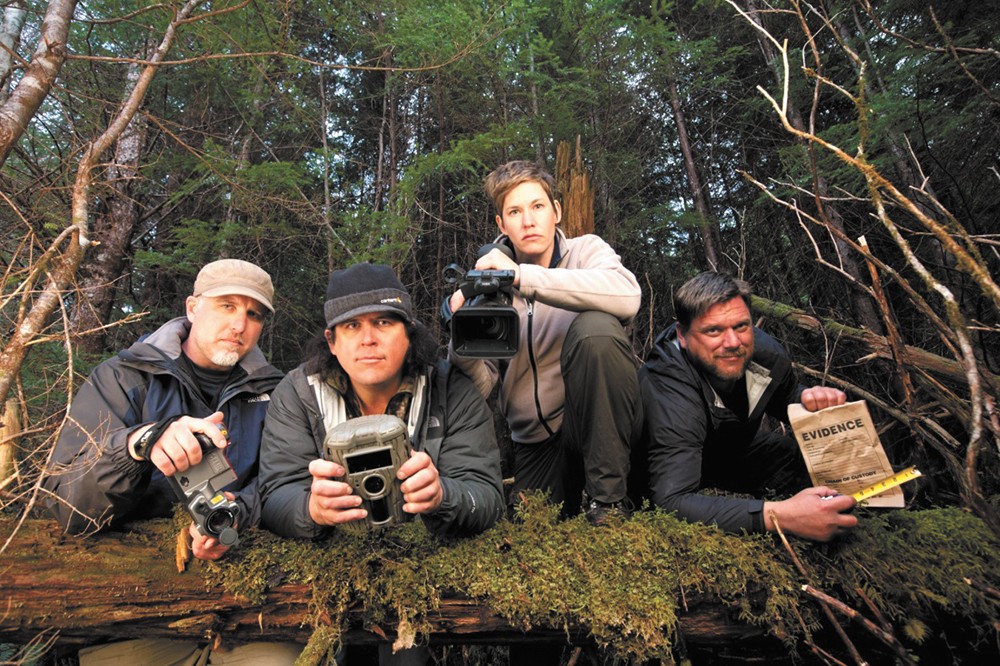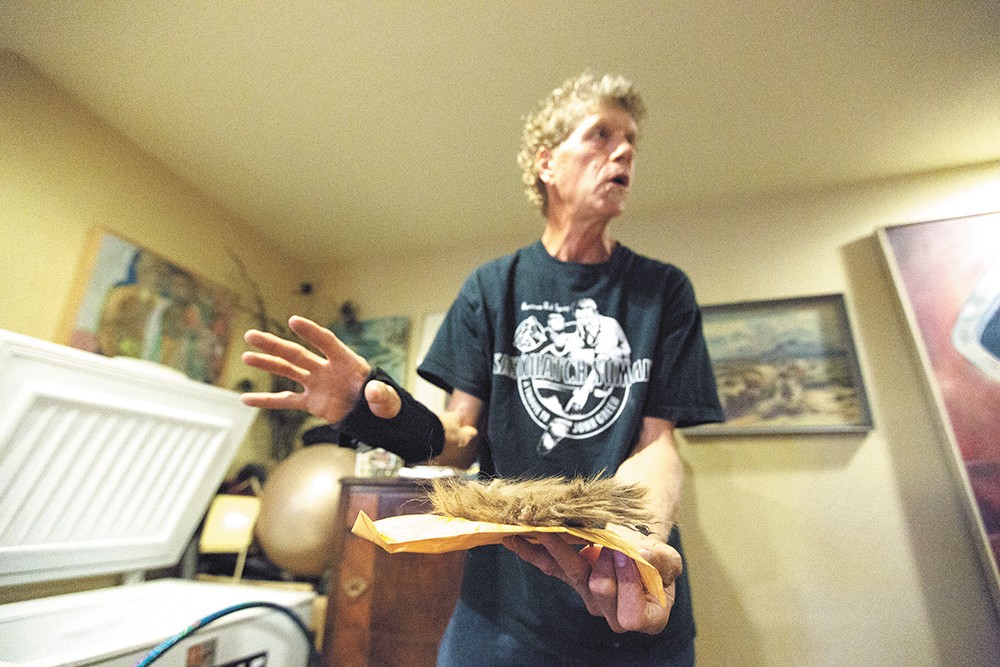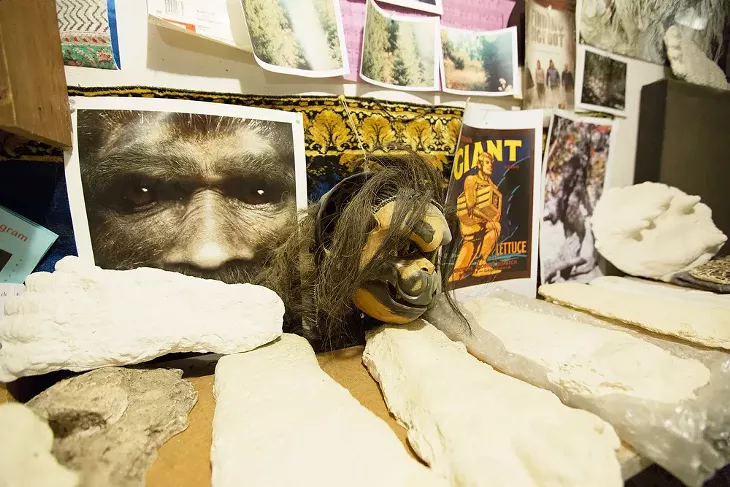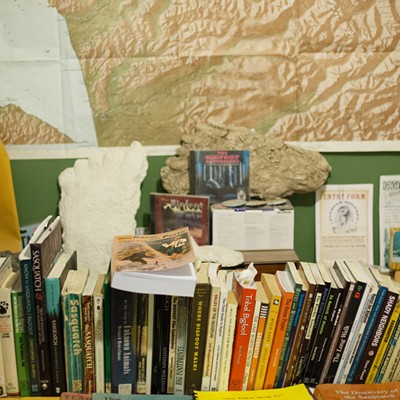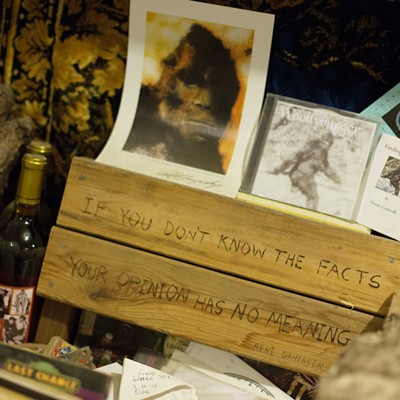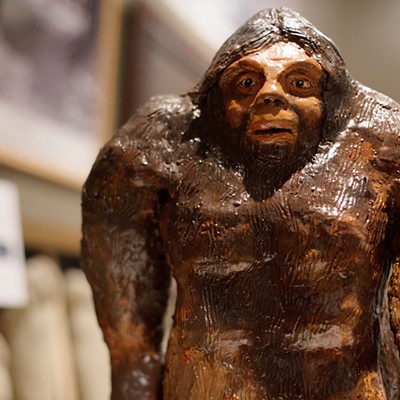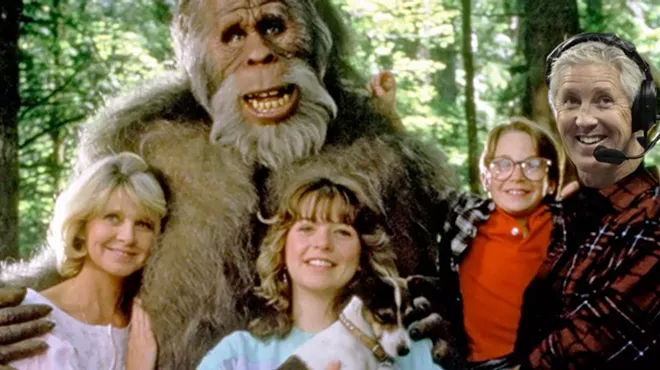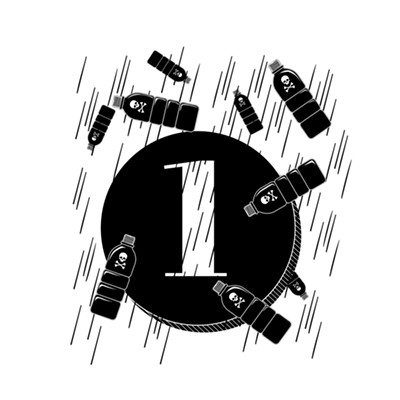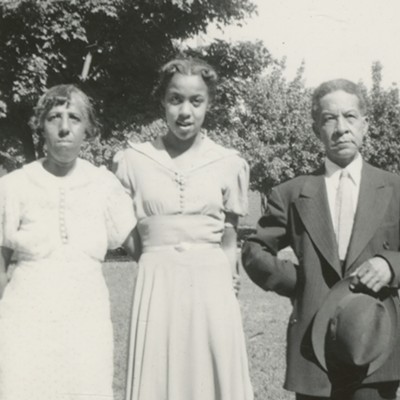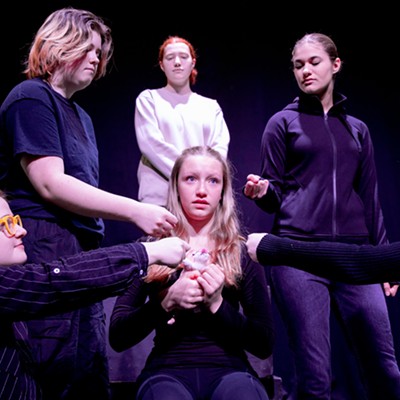You've probably seen her before. Captured in grainy 16mm Kodachrome color film, she walks upstream along a sandbar on the opposite edge of a creek. It's an easy gait, brisk yet casual. Her knees are bent; her elongated arms swing freely at her sides. In a moment suspended in time, she glances back. Large eyes. Flat nose. Well-muscled back, buttocks and thighs. A large pair of conspicuous breasts dangle from her chest like sandbags.
She's big — 7 feet and 3 inches tall, some say, and 700 or more pounds. She's also almost entirely covered in dark brown hair.
To skeptics, she's just a hoax, an imposter in an ape suit. But to any Bigfoot investigator worth his salt, she's "Patty."
This iconic footage, known as the Patterson-Gimlin film, is widely considered the gold standard by which every other piece of Bigfoot evidence is weighed. Cryptozoologist Loren Coleman, who runs the International Cryptozoology Museum in Portland, Maine, likens the footage to the Zapruder film of John F. Kennedy's assassination. It's the best and and most controversial proof there is that large and elusive apelike hominoids roam the North American backwoods, and have been since antiquity. For Bigfoot believers, the comparison couldn't be more apt.
No one appreciates this more than Bob Gimlin, an 82-year-old horse handler from Yakima, Washington — the surviving half of the film's namesake. When we meet at a diner in Union Gap, he says he's got "a little gift" for me out in his truck. After rummaging through his black Escalade pickup, he hands me a batteries-not-included "Sasqwatch" that he personally autographed the night before.
"That's a signed Bob Gimlin case right there!" he says, smiling.
Gimlin's a small, wiry old cowboy with an elfin grin tucked under a sparse handlebar mustache. He rolls into Shari's Cafe and Pies, his favorite local spot, in a cream-colored cowboy hat, mahogany leather boots and an Ellensburg blue agate stone on his left-hand ring finger. He orders peach ice tea and when I ask him how he is, he points to his left shoulder. He got bucked off a mule a few weeks back, and now his left arm is about as strong and useful as silly putty.
The course of Gimlin's life changed dramatically on Oct. 20, 1967: He and his old friend Roger Patterson spotted Patty (named after Roger's wife) lumbering along Bluff Creek in Northern California. They'd come to California from Yakima with two saddle horses, a pack horse and a rented Kodak K-100 hand-held camera after Patterson, a longtime Bigfoot enthusiast, caught wind of some giant footprints in the mountains 35 miles from the town of Willow Creek.
Gimlin didn't expect the ensuing hubbub, or that nearly half a century later, the film would still be a subject of intense study and debate in certain circles. Scientists from as far as Russia and London have examined the film and verified its authenticity. Yet his own neighbor down the street has gone on the record claiming that he was the man in the ape suit.
For Bigfoot believers like Gimlin, the enigmatic ape is just another rare and endangered species that hasn't officially been "discovered." And while almost every corner of land on Earth has been explored, they'll often point out that the mountain gorilla was considered a myth until it was shot and killed on an expedition through Central Africa's Verunga Mountains in 1902. Even Jane Goodall has admitted her fascination with the humanoid cryptid, telling a public radio reporter 12 years ago, "I'm sure that they exist."
Forty-seven years since the Patterson-Gimlin film's debut, the search for Sasquatch is as intense as ever. Jeff Meldrum, an anatomy and anthropology professor at Idaho State University — and one of the few academics publicly convinced by the body of Bigfoot evidence — is currently conducting his own DNA study of supposed Sasquatch hair samples. He's also involved with the Falcon Project, a $500,000 initiative to send an unmanned aircraft system, equipped with thermal imaging and high-definition video cameras, to search for Bigfoot above the treetops. The mission, he says, will likely launch within a year.
But any "Bigfooter" will tell you that this relentless quest for the creature demands a heavy price. For years, Gimlin wouldn't tell his story. The public scrutiny was too much; the ridicule was unbearable. His wife threatened to leave him many, many times. And he was bitter. Patterson cheated Gimlin out of the rights to the film, traveled around the country with it and made a whole bunch of money through movie ticket sales of BIGFOOT: America's Abominable Snowman! Gimlin never saw a cent. Now, within the passionate Bigfooter community, Gimlin has become a celebrity in his own right.
"I don't hold no regrets now," he says. "We've got the evidence now, the sightings. Thousands of people can't be wrong when they say they've seen 'em."
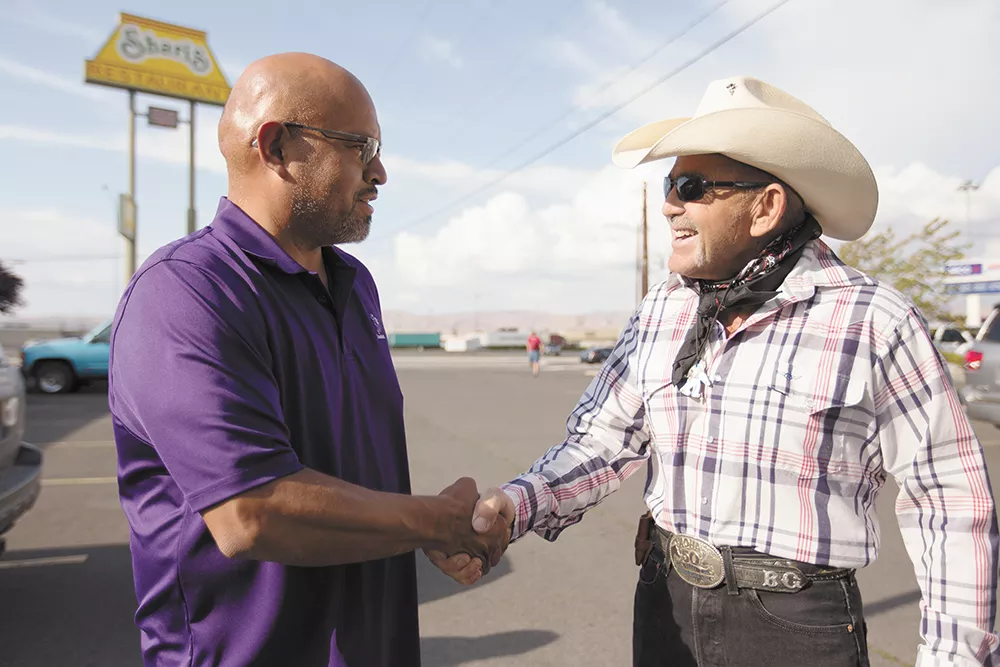
The legend of Sasquatch dates back to Native oral traditions. The name "Sasquatch," in fact, is derived from the Halkomelem Indian word sásq'ets. Even before 19th century newspaper reporters described sightings of "wild men" in the woods — Teddy Roosevelt once wrote about a bipedal "beast creature" who killed a trapper in the Bitterroot Mountains — Native people passed down their own stories of hairy giants wandering the wilderness.
The Spokanes called Bigfoot s'cwene'y'ti ("Tall, hairy, smells like burnt hair"). The Wenatchi called them choanito ("night people"). The Sasquatch is skanicum — "stick Indian" — on Colville lands and oh-mah — "boss of the woods" — among the Huppa in Northern California. To the Yakama, he's qah-lin-me — one of his "hairy brothers." He's the yeti in the Himalaya, the yowie in Australia and the yeren in the Hubei province in China.
Idaho State's Meldrum hypothesizes that Bigfoot is a relative of the genus Gigantopithecus, a 10-foot-tall prehistoric ape that roamed modern-day China, Vietnam and India more than one million years ago.
Ever since the release of the Patterson-Gimlin film, Bigfoot has catapulted into popular culture. His hulking visage has appeared in dozens of movies, television shows, documentaries, ad campaigns and even porny Kindle e-books. (Virginia Wade's Moan for Bigfoot has been downloaded more than 100,000 times on Amazon.) Coleman, the cryptozoologist, credits the 1972 Bigfoot horror docudrama The Legend of Boggy Creek with inspiring today's generation of Bigfoot hunters. In 1987, John Lithgow starred alongside Sasquatch in the box office hit Harry and the Hendersons. In 2011, Animal Planet's documentary series Finding Bigfoot aired. Its second season premiere drew 1.6 million viewers.
Back at the diner, when I ask Gimlin who the top Bigfoot researcher in Washington is, he says one name without missing a beat: "Mel Skahan is, as far as I'm concerned, the best there is."
A forestry technician for the Yakama Nation, Skahan's 47 and stocky with a shaved head and, on his calf, a recently acquired tattoo of a Sasquatch peeking behind a pine tree. When we meet on the reservation on a hot Friday morning at the end of July, he's got his 12-year-old tag-along partner, Fayedawn, in tow and a jam-packed schedule planned for the day: a five-hour tour of his past Bigfoot encounters around the 1.2 million-acre Yakama reservation and a visit to his semi-regular radio show, Beast Mode, where he and two other Bigfoot enthusiasts talk Sasquatch lore and take questions from listeners.
"They're people just like us, humans just like us," Skahan explains from behind the wheel of his Honda Pilot as we drive along Signal Peak Highway. "They just choose not to be part of this."
Skahan wasn't always a believer. But then, in the winter of 1999, he saw his first set of tracks while out on the job, measuring timber plots of Douglas and grand firs near the Toppenish Creek drainage. The footprints were 22 inches in length, longer than his own snowshoes, and the strides at least 5 feet. The toe prints were as big as a deck of cards. He and one of his coworkers followed the tracks for three hours. They came upon a second and a third set of footprints: one was 18 inches long, the other between 8 and 9 inches. "It was mind-boggling," he says. It made the tiny hairs on the back of his neck stand up.
Nine years ago, he had his first — and last — sighting, again on the job, when he says he spotted a Bigfoot beyond a slash pile 170 feet away. It was large, black and glistening, running with its arms straight along its sides, faster than anything he'd ever seen before. He's also heard Bigfoot vocalizations — screams, howls and growls. He's had rocks thrown at him. He says he once came close enough to smell their putrid body odor.
We stop the car in the forest where Skahan had his sighting and he mimics a Bigfoot location call for me. "I need my water because this one hurts," he says. He cups his hands around his mouth and makes three high-pitched calls.
Whooop! Whooop! Whooooooop!
We wait for a moment in silence when, suddenly, we hear a loud bellowing in the distance. Fayedawn stops pecking on her cellphone, and the two us exchange looks, mouths agape.
Skahan smiles.
"That's a cow," he whispers. And sure enough, five cattle emerge from the woods.
There was a time five or six years ago when Skahan would get calls from his neighbors and coworkers, asking him to look into strange sounds they'd heard or things they'd seen, and he'd chase every report of a possible Bigfoot encounter on every corner of the reservation, hoping for a photograph or a video. He appeared on TV shows and national radio programs. He did talks at schools, museums and summer camps. He invested $25,000 of his own money into tracking equipment, like his thermal camera, and research expeditions. He auditioned for Animal Planet's Finding Bigfoot. Skahan spent so many weekends in the woods with other big-name Bigfoot investigators, he grew distant from his kids. His wife eventually left him.
Skahan remembered something a former reservation Sasquatch researcher had warned him about: "You're not going to like where it's going to take you." He didn't know what that meant at the time.
"I was out being a rock star and just living the outdoor Sasquatch-research lifestyle. Then it dawned on me: What's going to happen [to them]?" he says. If the rest of the world got their hands on his research, knew what he knew about Bigfoot, would they drive these creatures off the reservation, or worse, into extinction?
Skahan invites me to go on an overnight Bigfoot expedition with him and some of his Bigfooter friends on the Olympic Peninsula the following weekend — as long as I promise not to reveal the location of the campsite in this story. Late Saturday afternoon, he texts me cryptic directions as I drive down a winding, two-lane highway. They go something like this: Pass mile marker __ and turn right at the next dirt road into the woods. Make a left at the tree with the number "__" painted on its trunk and go past a __-colored ribbon tethered to a branch. The opening to the campground is a quarter mile away on the right.
By the time I arrive, a dozen other people have already pitched their tents in the wooded area around a gravel lot and are reclining in lawn chairs beneath an open-sided tent, swapping stories over a Tupperware box of cookies. They're mostly white, middle-aged outdoorsy types with kids — and day jobs. For that reason, they ask me not to include their full names. Among them, there are two engineers, one high school vice principal, an archaeologist, an IT analyst, a construction subcontractor and a Department of Natural Resources forest enforcer.
About half are current or former members of the Bigfoot Field Researchers Organization (BFRO) — the self-described "only scientific research organization exploring the bigfoot/sasquatch mystery." The group has gained some celebrity in recent years thanks to Finding Bigfoot, which stars BFRO founder Matt Moneymaker and his quirky team of field researchers, investigating sightings of the hairy cryptid.
One of the campers, Scott Taylor, a Boeing engineer from Spanaway in a camouflage hat and "WATCH FOR SQUATCH" T-shirt, says the BFRO has collected more than 45,000 reports from people who either saw something, heard something or think they did. The BFRO's online database includes reported sightings from every state but Hawaii, every Canadian province and a handful of Eastern Hemisphere nations. Washington is the undisputed hub of Bigfoot activity with 585 listings on the database. In his eight years as a volunteer investigator for the BFRO, Taylor says he's personally looked into 136 of them.
Many of the campers here say that like Skahan, their fascination with Bigfoot began with an otherwise inexplicable encounter. A woman named Laura tells me she had her first sighting in 2004, while she and her husband were caving at Mount Adams. She remembers walking all alone down an abandoned forest road when she heard something scampering behind her. She turned around and there it was, in the distance, crossing the road. She says she realized it wasn't human when she noticed its hands hanging all the way down to its knees.
"It upset my whole worldview," she says. "I tried to go to sleep that night and the world wasn't the same place. I thought, 'If this exists, then what else exists?' My God."
She kept quiet about it for six years — she didn't even tell her husband because she was worried he would have her "locked up" — until she couldn't keep ignoring what she had seen any longer. That's how she met Taylor, when she filed a report with the BFRO. They talked on the phone for an hour.
"It was an incredible relief," she says, "for him to say, 'You're not crazy.'"
Here's what I learn from these Bigfooters in the next 24 hours: Never hold a staring contest with a Sasquatch. Keep any white lights turned off and stowed away. They're preternaturally strong, fast and clever. They have a penchant for chucking giant rocks at people when they're feeling threatened. They can swim 100 yards without coming up for air. They prey on deer. They fish for salmon. They like peanut butter sandwiches. If you set out a snack for them on a picnic table or back porch, like a bag of apples or watermelon rind, they might leave you a gift in its place — a pile of stones or feathers or 10 dead field mice wrapped in leaves of grass. The females secrete a pleasant, cinnamony odor. The males, according to Taylor, reek of "dead dog, B.O., urine and garbage — mixed together and set on fire." They migrate with their food supply. Like cats, their eyes glow in the dark.
They even have their own spoken language. Taylor fetches his laptop to show us some audio of the "Sierra Sounds," alleged Bigfoot "chatter" recorded in California's Sierra Nevada mountains in the 1970s. "They sound like Oriental samurai," a woman in bright pink lipstick and track pants leans over and tells me. Taylor plays the recording. For the next 10 minutes, we listen to a series of low-pitched snorts, grunts, wails and rapid-fire gibberish.
They're also creatures of tremendous contradictions. Despite their enormous mass, they can weave through the tree line undetected. Despite their super-powered strength, they're quickly scared off by bright lights. Despite their apparent interest in humans, it seems they'd rather not be found out. "They have a real aversion to video cameras," one woman tells me. "I don't know how," she says. "As soon as you have a video camera on, they're gone. It's really interesting. How do they know that it's there?"
And despite countless eyewitness accounts, no Bigfoot body has ever been discovered. A Bigfoot has never been hit by a semi or shot by a hunter's wayward bullet. There are no bones, no carrion, no fossil record, let alone any Bigfoot-sized scat.
"It really comes down to a very simple principle. In science and in biology, if you want to name a new species, you have to have a 'type specimen,'" says science historian Michael Shermer, founder of the Skeptics Society, an organization dedicated to rooting out fringe and pseudoscientific beliefs. "Not footprints, not grainy videos and definitely not stories of things that go bump in the night. You have to have an actual body. That's how it works. ... Without an actual specimen, it just doesn't count."
This dilemma isn't lost on Bigfoot researchers, and there's debate on this point among the community, separating the Sasquatch "hunters" from the "seekers." The late Grover Krantz, an anthropology professor at Washington State University and the first academic to seriously study the Bigfoot question, advocated killing a specimen — an idea that doesn't sit well with any of the Bigfooters I've met. In fact, in 1969, Skamania County, in Western Washington, became the first in the country to pass an ordinance prohibiting "any willful, wanton slaying of such creatures" — a felony punishable by five years in prison. The law was amended in 1984, making Skamania County an official "Sasquatch Refuge" and the crime of killing a Bigfoot a one-year, jail-time offense. (The law even forbids an accused Sasquatch killer from claiming insanity in his defense.)
Taylor says the BFRO is looking for "irrefutable video or photographs" to prove Bigfoot's existence, but in the age of Photoshop and digital editing, he admits that's an almost impossible undertaking.
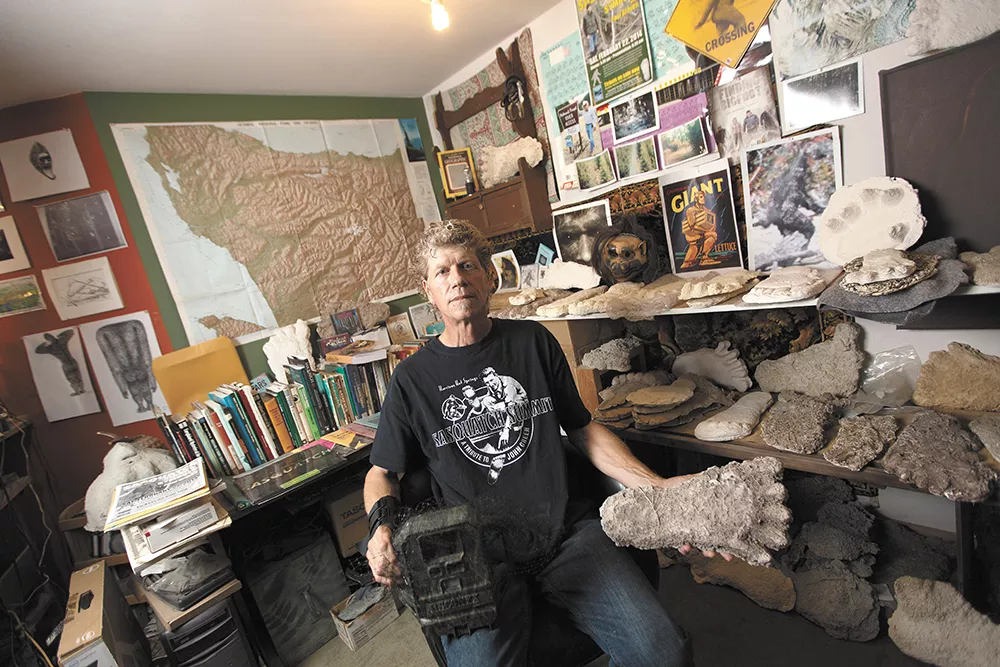
Still, Bigfoot investigators argue that the evidence weighs heavily on their side. Paul Graves, an investigator in Wenatchee, certainly thinks so, and he's eager to show me his findings when I visit his house on a Thursday afternoon in mid-August.
Graves is a concrete contractor, local musician and Eastern Washington investigator for a Bigfoot research group called the Olympic Project. (It's funded in part by a Nevada multi-millionaire named Wally Hersom, who outfitted members with more than 100 top-of-the-line infrared game cameras.) Graves, who is 53, lanky, blond and pale with soft blue eyes, calls himself a "citizen scientist," and he's been collecting Bigfoot stories all over the region, from Quilcene to Blewett Pass, for the past 25 years.
He's amassed some 360 reports, which he's handwritten and filed in composition notebooks and manila folders. His notes include observations like, "Saw Sasquatch near German Creek outside Longview Washington ... The one he saw had rounder head." Graves learned how to interview people from his mother, a former Wenatchee World newspaper reporter. Whenever he'd go out to grocery stores, restaurants, gas stations, he'd go up to folks and ask, "Have you ever seen a Bigfoot or heard of one?"
"I sometimes equate it to cancer research," he says of his work. "You see, we're working on a problem just like cancer; Bigfoot research. We put a lot into it, but we still don't have the answer. Just because we don't have the answer doesn't mean that it's not real."
His basement office is a shrine to both of his passions — Sasquatch and music. On one side of the room he's got guitars and camping gear; on the other side, he has his own personal museum of Bigfoot memorabilia and artifacts: dozens of plaster casts, books, photographs, posters and knickknacks. He has two of the same autographed pictures of Bob Gimlin posing in his trademark cowboy hat against a Bluff Creek National Forest sign. He gives me one of his CDs, an eight-track album of original "Sasquatch Songs." His acoustic guitar ballad "Bigfoot and Butterflies" includes lyrics like "One's so big, he's the king of the hill. / The other's so fragile, she's the queen of the mill. / Together they're like the keepers of the land. / Watching over everything with a soft hand."
In his fridge, he's got what he says may be a tuft of Bigfoot fur. He pulls it out of an envelope lying next to a big box of Northwest ground beef. It's a matted lump of straight brown hair, curiously square-shaped and reeking of fish food.
In 2010, Graves captured what he says is one of his most compelling, "blow your mind" pieces of evidence. He was hired by Finding Bigfoot for an episode recreating the Patterson-Gimlin film. While he was hiking in the woods near the Bluff Creek drainage, he says he recorded a video, with a small contour camera on his back, showing a Bigfoot running at extraordinary speed between a set of trees.
"They just glide, just like this," he says, moving his hand back and forth. "Like a ghost, like a ninja. It's moving so fast you can't even see it hardly in the film. When you slow it down, oh my gosh, there it is."
We gather around his computer and he presses play. About four minutes in, a dark, unidentifiable blur shivers between the trees.
"Weird, huh?" he says. "That something could move that fast."
"Now watch this," says Dave, the archaeologist, handing me his night-vision monocular back at the Bigfooters' campsite. "It's infrared light. So if you look at it with your naked eye, you can't see anything, right?"
No, you can't. But through the scope of his night vision, the world is green and radiant, surrounded on all sides by coniferous trees scraping the sky. It's 10 'til 10 and we've just set off from the trailhead and into the inky darkness. We've split off into two groups — Taylor leads mine — and we tromp along the hiking path, guided only by shadows, starlight and Taylor's red-light headlamp, stopping briefly a few times to listen for rustling in the underbrush. About 40 minutes in, we reach the end of the trail.
"Let's stop the lights and stand here about 10 or 15 minutes," Taylor says.
Laura adjusts her "Super Ear" sound enhancer and Taylor sneaks off to take a whiz. I ask Skahan if he'll do a howl.
"I'll call in more cows!" he says. But he takes a deep breath anyway and Taylor radios the other group.
Woahhhhhhhhhhhhh!
Skahan's got a reputation for being the best howler in Washington state ("I'm not even Obi-Wan to Mel's Yoda," one camper tells me), and it's obvious why. His howl is a long, deep, sonorous baritone, his pitch perfectly steady. It echoes throughout the forest.
Skahan howls again and we wait in total silence. Beyond the woods, you can hear the whooshing waves of the Pacific Ocean and the soft trickling of a nearby culvert. A foghorn blows in the distance. A twig snaps. Six minutes go by. Nothing.
"Well, I'm gonna call it," Laura whispers. "They're not much for knocking out here — are they, Scott?"
"No, not really."
"How about rock clacking?"
"Hmm," he pauses. "No, not really that much either."
"Maybe they all went down to get some seafood."
Taylor chuckles. "Maybe they're back terrorizing base camp."
We wait another three minutes before heading back down the trail to turn in for the night. And no, there's no Bigfoot at base camp either. The guys get a crackling fire going and I stumble off to my tent. One camper loans me an air mattress and another leaves me with a heap of blankets because, despite having borrowed a tent and sleeping bag for the occasion, I'm still hopelessly unprepared. One woman slips me a roll of toilet paper and a plastic baggie and when I ask, teaches me how to pee outside.
The next morning, there's no Bigfoot activity to report, and the overwhelming consensus is that one weekend in the woods is far too short to expect anything.
"They can't stay in one place permanently," Taylor explains.
"They could be just up the road at West Twin or the Lyre River," another says. "Especially if there's salmon coming in."
"Can we come back in two weeks?"
After breakfast, we say our goodbyes and I make the long, six-and-a-half-hour drive home. We didn't find Bigfoot last night, but I think I stumbled on something else. And more than I ever would have imagined, I want to come back, too. ♦
This story has been updated since it was originally posted.


